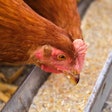Broiler foot-pad contact dermatitis (also known as pododermatitis) remains a production and welfare problem for the worldwide broiler industry as it reduces profitability and causes suffering to birds. In fact, regulations exist in several European countries that try to control this problem by reducing stocking density where broiler foot-pad dermatitis remains a chronic issue. Alternative solutions are currently explored to allow broiler production at higher (normal) stocking densities, and of course, nutrition can be part of the solution.
Wet poultry litter
The problem of foot-pad dermatitis has been associated primarily with wet litter (as complicated by moisture, nitrogen content and pH) that is caused by excessive water intake and excretion. To this end, controlling protein intake and balancing dietary electrolytes are the usual methods employed to control water consumption to levels required for broiler maintenance and growth. Avoiding excessive water intake to rid the organism from surplus protein and electrolytes is only a first-step approach to a complicated problem.
Enhancing the resistance of the foot pad to reduce its damage from contact with wet litter is another approach. Adding extra zinc and biotin often is advocated as both nutrients are involved in the development and maintenance of the vulnerable tissues in the foot pad. Although adding high levels of zinc is not allowed in the European Union, it is always advocated to use the highest amount possible (150 mg/kg), in addition to a super-high dosage of biotin (1,000-3,000 micrograms/kg feed, as opposed to normal specifications of 100-300 micrograms/kg). Other trace minerals, such as cooper and manganese also can be beneficial.
Broiler diet
Feeding a coarsely ground diet tends to reduce litter moisture and consequently food-pad dermatitis problems. However, results remain inconclusive. Interestingly, it has been suggested that wheat-based diets tend to increase the incidence of broiler foot-pad dermatitis as opposed to corn-based diets. This is perhaps best explained by the presence of viscous non-starch polysaccharides in wheat that result in increased excreta moisture.
Other, but related to the above, suggestions to combat this issue involve the use of enzymes, organic minerals, and organic acids; but again, it appears no single approach can resolve alone the incidence of foot-pad dermatitis. Instead, nutritionists have developed diets specifically to prevent broiler foot-pad dermatitis (along, of course, with other management intervention measures). Such a diet would include a combination of the above nutritional intervention measures, but at an increased cost, which should be always outweighed by the loss of profitability caused by foot-pad dermatitis. It has been reported that using such diet can reduce the incidence of foot-pad lesions in both feet of male broilers grown to 40 days of age by almost half-a very significant reduction!
Problems associated with wet-litter conditions remain one of the important issues of the broiler industry. Nutrition can definitely play a role in preventing or at least alleviating these problems, as in the case with foot-pad dermatitis that is receiving renewed attention as broiler genetics continue to provide an ever-younger bird with a heavy body weight.

















